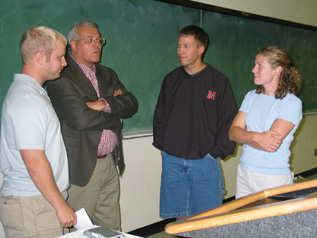 |
Joe Jacobs, second from left, visits with UNMC students, from left, Jesse Pandorf, Jason Hesser and Liz Jaben before Jacobs’ presentation Thursday. Pandorf is this year’s president of the Student Association for Rural Health (SARH). Hesser is the group’s vice president and Jaben is its treasurer. |
“You have to achieve a level of understanding of what the patient’s needs are,” Joe Jacobs, M.D., said. “You have to be prepared to expect that patients won’t always follow your advice.”
Dr. Jacobs spoke at noon Thursday during the first meeting of the school year of the Student Association of Rural Health (SARH). He is the former director of the Office of Alternative Medicine of the National Institutes of Health and is a past president of the Association of American Indian Physicians.
Dr. Jacobs gave a brief history lesson of American Indian health care to the students in attendance. He said the care of the American Indians improved significantly after Congress approved the 1954 Transfer Act, which transferred all American Indian health-care programs and responsibilities from the Department of Interior’s Bureau of Indian Affairs (BIA) to the Department of Health, Education, and Welfare’s Public Health Service (PHS). The Indian Health Service (IHS) began a year later.
During his three years as a pediatrician on the Navajo Reservation in Arizona, Dr. Jacobs said, he realized that the people were more accepting of him as he began to use their native language to greet them and ask them basic questions.
“When you talk about how you communicate with patients, language is of paramount importance,” Dr. Jacobs said, noting that his attempt at the Navajo language showed the people that he was trying to learn something about them.
Dr. Jacobs said that while Western medicine focuses more on curing a patient’s illness, American Indian tradition uses a more holistic approach.
“Working with the Navajos was really quite an edifying experience,” he said.